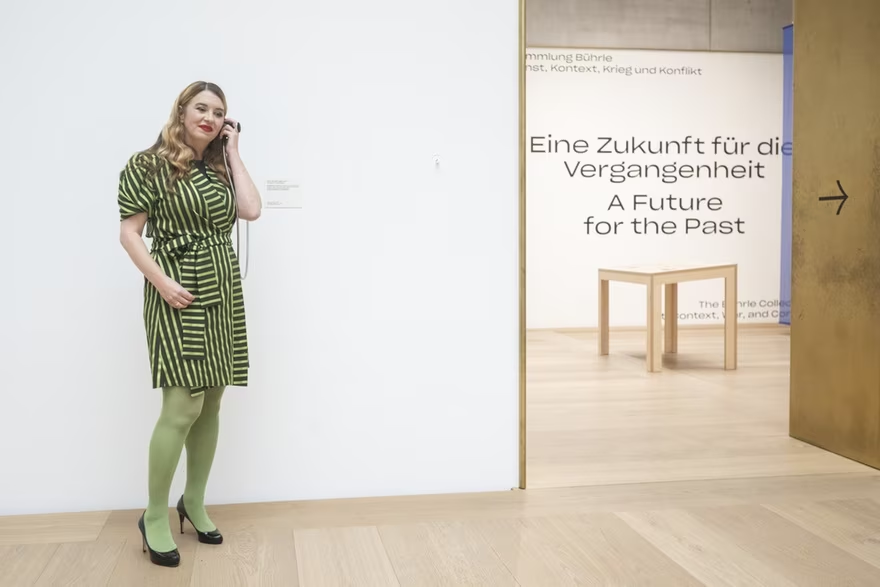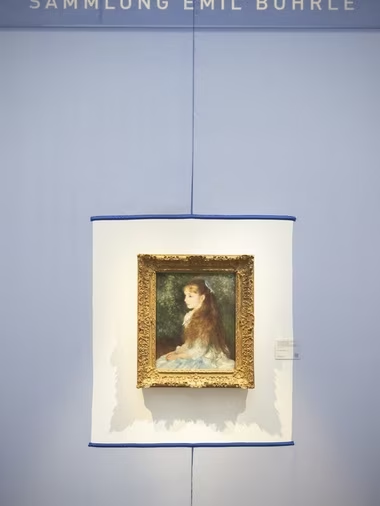News:
Bührle Collection: Ann Demeester on art, war, and context
The Kunsthaus Zürich is making another attempt to deal with the controversial Bührle Collection. SWI swissinfo.ch spoke to director Ann Demeester about the exhibition.

The Belgian art critic Ann Demeester assumed the direction of the Zurich Art Museum (Kunsthaus) in 2022, taking over the responsibility to reassess the Bührle Collection and expose the umbilical relationship between the museum and the arms dealer.
In autumn 2021 the Kunsthaus Zürich opened an exhibition of mainly Impressionist artworks, on loan from Emil Bührle's Foundation. From the beginning, the museum was internationally criticised for this: Bührle was an arms dealer and had acquired several works during the Nazi regime and circumstances that have since been clarified.
In addition, the foundation interfered in the clarifications about the historical background of the controversial collection before it was opened. Now, under new director Ann Demeester, the museum has ventured a new beginning and revised the exhibition – the acquisition context of the paintings should be shown more strongly – under the title "Art, Context, War and Conflict".
Demeester explained to SWI swissinfo.ch her approach to dealing with the collection, in a clear break with her predecessor’s, and the different situation she faces at the Kunsthaus Zurich compared to the Bern Art Museum (Kunstmuseum Bern), which also had to deal with another high-profile case, the Gurlitt Collection.
SWI: In another interview, in 2022, you said that art is at the mercy of history after the death of the artist. So are you sometimes angry at Emil Bührle because of what he did to this art?
Ann Demeester: I try not to be angry with dead people. That doesn't help much. But I am always aware of the fact that with the Bührle Collection, art and history can never be separated. The works of art themselves are innocent, but they are the testimonies of crime and deep injustice. They have also become documents of remembrance of the terror of the Nazi regime.
With this exhibition we want to show both: this is a beautiful collection of extraordinary masterpieces. But it is also controversial. There are works in it that previously belong to Jewish collectors, which are cases of discussion. And even the other artworks were bought with Emil Bührle's capital, a capital that came in large part from arms sales to Nazi Germany.
SWI: Why exactly did Bührle buy these paintings?
A.D.: Bührle bought first-class artists of high quality, valuable blue-chip art. His interests ranged from the Old Masters to medieval sculpture and early classical modernism. He had an aversion to abstract art. At first he didn't want to buy Picasso either because he was a communist, but I was told that he did it anyway because Picasso was already part of the canon at that time. Bührle was strongly oriented towards the names of the art canon.
SWI: Rarely has there been so much talk about Kunsthaus Zürich as in the last two years. Is this also an opportunity?
A.D.: That would be cynical, there is too much suffering behind this collection. But I think the Bührle Collection has forced us to take our role seriously, to face the world and not just be a beautiful arts palace. We have to be a museum of today that also has painful discussions and cannot always wallow in harmony.
SWI: A week ago, there was a setback: the scientific advisory board resigned in unison.
A.D.: Without the advisory board, this exhibition would look different; they have given us incredibly important feedback over the last 12 months about the themes of the exhibition and how to actively invite the public to participate. Without them, we might have taken a very different perspective. But in the end, they felt that Bührle is still too much in the centre and that the victims are not sufficiently in the centre. We respect that, but we see it differently.
A "history of beneficiaries": Why the Scientific Advisory Board resigned
One week before the opening, the scientific advisory board resigned - after numerous internal statements. The members of the advisory board criticised the fact that the exhibition still focused too strongly on the figure of Emil Bührle as the central theme. In their view the new exhibition marginalises the victims of the politics, from which Bührle profited as an entrepreneur and collector.
Also, they argue that the the lives of the previous owners of the works are not sufficiently acknowledged. The exhibition focuses on the "history of the beneficiaries" instead of highlighting figures, who fundamentally shaped modernism through their support of artists.
They say the exhibition also does not show the National Socialist extermination policy, which is central to the history of the collection, in enough detail, nor does it show Switzerland's policy during the Second World War - "the exhibition also remains silent on Switzerland's role as a central reloading point for looted works or works sold as a result of flight,“ Stefanie Mahrer, Member of the Advisory Board said.
End of insertionSWI: One criticism of the advisory board is also that the pictures can be viewed without disturbance, that the historical context from which the pictures come is not shown prominently enough.
A.D.: It is our duty as a museum to explain the context of the pictures. But we don't want to cover them with layers of information or cover them up just to make it more obvious. We want the works to breathe and also to be able to exist as works of art.

Pierre-Auguste Renoir's "La Petite Irène" (1880)
In our opinion, you can't avoid history in our exhibition: it deliberately starts with a painting that is beautiful but has a very complex, painful history: Renoir's portrait of Irène Cahen d'Anvers. We want to allow visitors to see this painting as an impressionist masterpiece.
But they should also learn that behind the painting was a life of war, loss and death - Irène Cahen d'Anvers' entire family was murdered in concentration camps, her portrait confiscated by the Nazis. After the war, it was returned to her before she sold it to Bührle in 1949.
SWI: How did you manage to show this?
A.D.: Even after the first room, the path through the exhibition is predetermined; the viewers have to pass through the video statements on the exhibition, through the room that talks about the fate of the Jewish collectors, as well as through the one on provenance research.
SWI: At the end, the visitors enter a room where they can also give their own opinion.
A.D.: I'm interested in the reactions, me and my team are very curious about that. We also have a weekly session where we would like to talk to the audience personally. What concerns do they have, what concerns do they bring up? This exhibition is not an end point for us: what do we take away from it into the next phases of the exhibition? How should it change?
We don't want to please everyone. Nor will we be able to respond to everything. But we want to understand which discussions are important for our visitors. We will continue to invite experts. If we had to go back in time, we would invite the advisory board again immediately. Without doubt, without hesitation.
SWI: To what extent does the debate about Bührle transcend the Kunsthaus?
A.D.: I hesitate. I've been in Switzerland for a year. As a recent immigrant, I have to be somewhat reserved. But I do think that the Bührle Collection is a pars pro toto [a part taken for the whole, in Latin] and stands for much more than just this collection.
People keep telling me that it can be a kind of rubbing stone for further publicising the history of Switzerland during the Second World War. Many people I spoke to said that we are entering a new phase of remembrance in which Switzerland's role will be questioned even more.
The question is not so much one of guilt or innocence, but perhaps of what neutrality meant back then? What it meant in a world war to be politically neutral and to continue to trade with everyone? But for that, we need debates outside the Kunsthaus that relate to existing research.
SWI: You're talking about the public debate now, but there is also a kind of diplomacy with the Bührle Foundation and the Zürcher Kunstgesellschaft. Were there any stipulations there?
A.D.: The Bührle Foundation didn't impose any constraints on us. The collection still has to stay together, but we are free to curate. That was a clear development - but I don't want to prejudge the facts. It is also uncertain what the provenance research of the historian Raphael Gross, who has been commissioned to review the provenance of the paintings, will bring.
SWI: Can we expect a model similar to the one in Bern - that in cases of suspicion, works are returned to their rightful owners?
A.D.: We have great admiration for the work of the Kunstmuseum Bern, but I think there is a big difference between their situation and ours. The Kunstmuseum Bern is the owner of the suspect works. We are not in the case of the Bührle Collection. That is not an excuse, but a fact.
We introduced a new provenance research strategy for our own collection in March 2023. For the works in our own collection, the circumstances and the strategy are clear - but not yet for the art collection of the Bührle Foundation.


